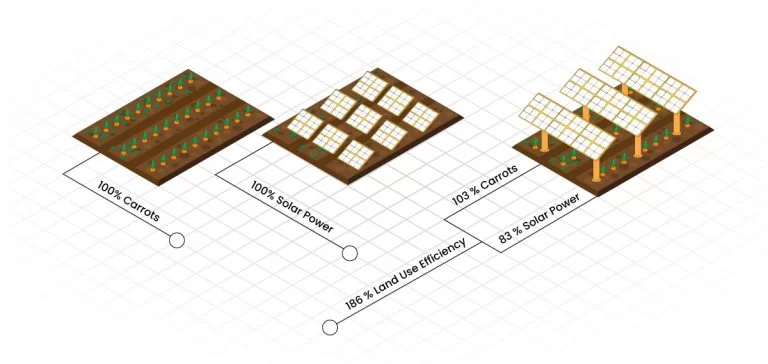
The world is at a crossroads, grappling with the ever-increasing demand for renewable energy sources and sustainable agricultural practices. One innovative concept that's emerging as a potential solution is agrivoltaics.
The term "agrivoltaics" describes a remarkable synergy between agriculture and solar energy, offering a unique way to harness the power of the sun while cultivating our lands more sustainably.
New era for sustainable agriculture and solar panels
Agrivoltaics pairs solar panels with agricultural fields, creating a harmonious coexistence where both renewable energy generation and crop cultivation thrive. Solar panels, typically designed to capture sunlight and convert it into electricity, are now playing a dual role as shade providers for crops and energy sources.
These projects are not only environmentally responsible but also economically viable. They allow farmers to maintain food production while producing electricity. Under the right conditions, crops and solar production can actually enhance each other, providing surprising economic and ecological benefits.
Making the Most of Every of farm
One key aspect of agrivoltaics is its efficient use of land. Traditional solar installations may occupy vast areas, potentially taking agricultural land out of food production.
However, agrivoltaics creates a unique opportunity for both agricultural and solar activities to thrive on the same land. In areas where land is limited, such as mountainous regions, agrivoltaics can be a game-changing solution to meet energy and food production needs with the help of solar panels.
Benefits Beyond Solar Energy Generation
Agrivoltaics go beyond energy production. They offer various benefits that contribute to the sustainability of both agriculture and renewable energy generation:
Ecosystems and Biodiversity: Agrivoltaic systems support native habitats, creating spaces for pollinators and beneficial insects. This not only saves on maintenance costs but also fosters biodiversity and protects ecosystems.
Reduced Water Consumption: By providing partial shade for crops, solar panels reduce water consumption for irrigation, especially in arid climates. This water-saving approach ensures efficient land use.
Additional Income for Farmers: Agrivoltaics create opportunities for farmers to generate additional income by co-locating crops and solar installations. This additional income can be reinvested in their farming business.
Community Collaboration: Agrivoltaic projects encourage collaboration among various stakeholders, including farmers, local communities, and solar developers. These collaborative approaches lead to the creation of innovative solutions and shared value.

Agrivoltaics with Bifacial Solar Panels
In the world of agrivoltaics, where agriculture and solar energy seamlessly coexist, the role of bifacial solar panels takes center stage. These exceptional panels, with their dual-sided light absorption capability, are uniquely suited to this innovative synergy.
The pivotal advantage of bifacial panels lies in their transparency, which is a game-changer for agriculture. This exceptional trait, a departure from traditional solar panels, means that plants beneath the panels can bask in the sunlight necessary for their photosynthesis.
The result is a thriving ecosystem where agriculture and solar power unite in perfect harmony. This promising development not only fosters sustainable food production but also enhances the overall efficiency and benefits of agrivoltaic systems, ushering in a greener and more promising future.
The future of agriculture with solar panels
The early results of agri voltaics are promising. Not only do these projects efficiently harness solar energy, but they also create beneficial microclimates for crops, improve yields, and contribute to water conservation. The collaborative efforts of researchers, agricultural enterprises, and the renewable energy industry are making agri voltaics a sustainable model that can be adopted globally.
The concept of agri voltaics signifies a new era for sustainable agriculture and renewable energy generation. By co-locating solar panels and crops, we can strike a harmonious balance between food production and clean energy. These innovative projects offer a glimpse into the future of farming and energy generation, showcasing how a collaborative approach can yield beneficial results for both the environment and communities.
As we navigate the challenges of climate change and increasing energy demands, agrivoltaics serve as a shining example of how human ingenuity can create a brighter and more sustainable future for all.